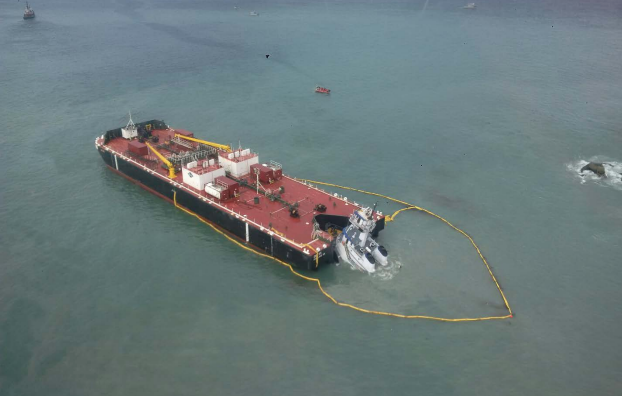The second mate of the articulated tug Nathan E. Stewart fell asleep in the wheelhouse before the tug and its ATB barge DBL 55 ran aground in the Seaforth Channel of British Columbia, ultimately sinking the tug and releasing 29,000 gals. of fuel, the U.S. National Transportation Safety Board reported.
The crew of the Kirby Offshore Marine ATB failed to follow the company’s safety management system, in that a second watchstander should have been on duty with the second mate, NTSB investigators found.
While not required equipment, a pilothouse alerter system – a monitoring system that requires periodic inputs from a crewmember or it sounds an alarm – might have helped avoid the accident, the NTSB report noted. Those alerter systems are being phased in as part of the Coast Guard's Subchapter M safety requirements for towing vessels.
The Stewart accident led to a month-long cleanup and recovery effort that focused attention on longstanding complaints from First Nation and environmental groups that more must be done to protect the Inside Passage from petroleum spills.
The Canadian government pledged more money and resources for maritime response. The debate was renewed in recent days, after a Harley Marine Services ATB separated during a transit off British Columbia. The vessels were safely recovered with no spills, but the Heiltsuk First Nation renewed its call for a locally based maritime response force.

The tug Nathan E. Stewart was recovered by heavy lift crane a month after its October 2016 sinking. Kirby Offshore Marine photo.
According to the report’s narrative the crew of the 95'4"x32’x12’, 3,400-hp Nathan E. Stewart and its 287'6"x77’8"x8’ double-hulled barge had discharged the last of their fuel cargo at Ketchikan, Alaska, on the evening of Oct. 11, and were on a southbound transit to Vancouver, British Columbia.
Under rules of the Pacific Pilotage Authority, Kirby held a waiver allowing specific tugs and barges in its fleet, operated by deck officers who met sea time requirements for the route, to make the transit without a pilot.
However, the second mate was not on the PPA-approved list, and the captain told investigators he was not familiar with the pilotage requirements and the specifics of Kirby’s waiver. The company’s own safety management system required an additional watchstander in the wheelhouse along with a licensed deck officer while underway in pilotage waters, unless the second watchstander was making safety checks or other tasks of short duration.
At 11 p.m. the second mate relieved the captain in the wheelhouse – an hour ahead of the scheduled midnight watch change, the report noted. At 12:24 a.m., the second mate made a course change with speed over ground of 9.3 knots.
Nearly half an hour later at 12:53 a.m. the second mate missed a waypoint near Ivory Island, where according to the voyage plan he should have altered course to port, the report says.
Around 1 a.m., a tankerman tried to call the second mate on his handheld radio. Not hearing a response, he began making his way up to the wheelhouse when he felt the ATB shudder. The second mate came on the radio, telling the tankerman they had run aground.
The ATB was hung up on Edge Reef, rocks off Athlone Island in the Seaforth Channel. Over the following hours, Canadian coast guard units responded as the crew transferred fuel from the tug to an undamaged barge tank, used dewatering pumps and deployed a containment boom.
Tidal forces and wave action were beating the grounded tug. Around 9:27 a.m., the stern of the tug partially submerged as the chief mate, engineer and second mate were on the main deck.
“The chief mate and second mate were swept into the water by waves, while the chief engineer was swept forward and managed to grab hold of the tow winch system,” the NTSB report says. A coast guard crew recovered the chief mate from the water, as the second mate pulled himself along the port side of the tug, got back o board, and then climbed to the barge. By 9:37 a.m. all seven crew were safely on a Canadian cutter.
Around 6:40 p.m. the barge separated, leaving the tug sunk in 28’ of water. The barge was towed to a safe anchorage, but it would be a month before a heavy lift crane could finally recover the battered Nathan E. Stewart. Among overall damages to the vessels of $12 million, the tug was a total loss.




